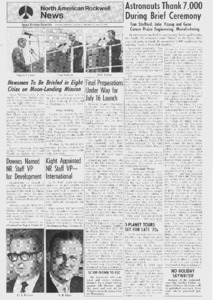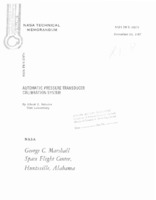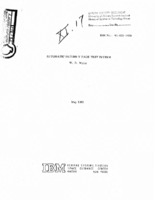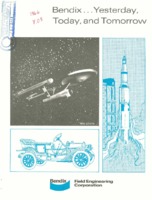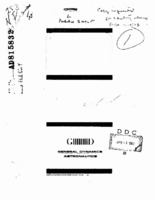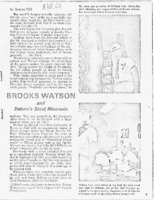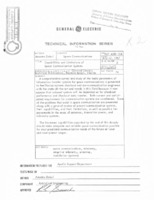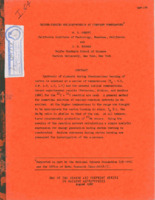
Browse Items (970 total)
Sort by:
-
"Astronauts thank 7,000 during brief ceremony."
A news article detailing a ceremony in which astronauts thank the crew who built their rocket. -
"Automated PCM Data Processor Theory of Operation."
Includes a blueprint of DDAS System Block Diagram. -
"Automatic Pressure Transducer Calibration System."
The abstract notes, "The development of an automatic pressure transducer calibration system is discussed in this report. Evolution from past practices and systems into an automatic calibration system with computerized data handling is described." -
"Automatic Saturn V Page Test System."
The abstract notes, "This paper describes the Automatic Saturn V Page Test System. The system is used to evaluate microminiature Unit Logic Device (ULD) circuits. A page is an assembly consisting of a magnesium- lithium frame, an input-output connector, test points, and multilateral printed circuit boards that interconnect the IUDs into logic circuits. The test system automatically performs tests for shorted voltages and shorted diodes, static logic function, and pulse function." -
"Bendix: Yesterday, Today, and Tomorrow."
This history has been abstracted from the text of a speech given by Mr. A. P. Fontaine, Chairman of the Board and Chief Executive Officer, The Bendix Corporation to the Newcomen Society of North American on December 8, 1966. This Newcomen address was delivered at the "1966 Michigan Dinner" of the society held at Detroit, Michigan when Mr. Fontaine was the guest of honor. Portions of Mr. Fontaine's talk relative to the Baltimore Divisions and Bendix Field Engineering were amplified locally to provide more historical detail concerning those organizations.; Stapled to this brochure is a letter to Mr. David L. Christensen, Documentation Coordinator, Saturn History Program, University of Alabama, Huntsville from Paul R. Leatherwood, Jr., Director, Public Relations, Bendix Field Engineering Corporation dated August 26, 1969. -
"Bibliography of Research and Development Reports on the Centaur Program for Period 1958-1962."
Contract AF 18(600)-1775AD 815-832. Original is 6 sheets of microforms. Pages i, ii, iv, vi-xii, 110 and 344 missing on microforms. The title page notes that the document "Supersedes AE62-0400 and Supplements -A, -B, & -C." -
"Brooks Watson and Saturn's Steel Mountain."
Included are a copy of page 7 of the December 1963 publication of Pan Am (GMRD) Clipper magazine and a letter from Pan American World Airways to David Christensen. The magazine article briefly describes the gantry that surrounded Saturn-V and Pan American's Saturn complex Supervisor, Brooks Watson. -
"Capabilities and Limitations of Space Communication Systems."
The paper "Capabilities and Limitations of Space Communication Systems" is part of a General Electric Technical Information Series prepared for the Apollo Support Department. The abstract states "A survey and study of the basic parameters of information transfer systems for space communications is presented in this paper, to familiarize systems checkout and on communication engineers with the state-of-the-art and trends in this field. Both current and anticipated requirements for space communication systems are briefly considered. Some of the problems that exist in space communication are presented, along with a general review of current communication systems, their capabilities, and limitations as well as possible improvements in the areas of spacecraft directional antennas, ground stations and antennas, spacecraft transmitter power, and telemetry systems. It is concluded that the increased capabilities expected by the end of this decade should make adequate and reliable space communication possible for most predicted communication needs of future space missions at lunar and near-planet ranges." -
"Carbon-Burning Nucleosynthesis at Constant Temperature."
"Carbon-Burning Nucleosyntesis at Constant Temperature" is part of the Orange Aid preprint Series in Nuclear Astrophysics, August 1968. The abstract states "Syntesis of elements during thermonuclear burning of carbon is examined at a series of temperatures (T=0.6, 0.8, 1.0, 1.2, 1.4) and for several initial compositions. Recent eperimental results (Ptterson, Winkler, and Zaidins 1968) for the 12C+!@C reaction are used. A general method for numerical solution of nuclear-reaction networkds is described. At the higher temperatures in the range now thought to be appropriate for carbon burning in stars, -
"Chemistry in Space Boosters" presentation given at Huntsville High School.
The document is a draft of the presentation "Chemistry in Space" by Harold Perkins, who explains the role of chemists in developing space launch vehicles. The document Includes references to charts and other presentation supports. The document is marked in the upper left hand corner "Huntsville High School Science Organization (the JETS), October 1962."
